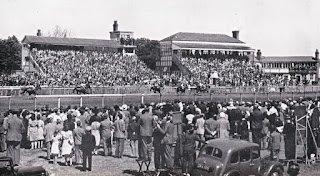With apologies to a Shropshire Lad…
Into my heart an air that kills from yon far country blows:
What are those blue remembered hills,
What spires, what farms are those?
That is the land of Folkestone Racecourse, I see it shining plain,
The happy races where I went
And cannot come again.
Despite welcoming the happy news of Hereford’s resurrection (next meeting 19th December), I can’t help but mourn the loss of Folkestone Racecourse. The track, which closed four years ago this month, was the only racecourse in Kent and now looks likely to subside under a blanket of housing. Shepway Council is progressing plans for a 12,000-house development called Otterpool Garden Town.
In addition to being the only racecourse within cycling distance of my childhood home, Folkestone was also the subject of my first venture into racing politics – a letter to The Sporting Life, in 1985, defending the track from Tom Kelly, of the Bookmakers Offcourse Licencees Association (Tom-BOLA - no seriously, that's what they called him), who suggested that the course was a drain on the industry’s resources and should be closed with immediate effect.
In addition to being the only racecourse within cycling distance of my childhood home, Folkestone was also the subject of my first venture into racing politics – a letter to The Sporting Life, in 1985, defending the track from Tom Kelly, of the Bookmakers Offcourse Licencees Association (Tom-BOLA - no seriously, that's what they called him), who suggested that the course was a drain on the industry’s resources and should be closed with immediate effect.
There were more in the industry who would have agreed with him. Throughout the 1980s, The Sporting Life ran a regular column in which racing personalities were asked 20 standard questions, including: Name your least favourite racecourse. Folkestone was the most popular response by quite a long way. Probably because, if you didn’t live in Kent, it was a long way.
When John Francome retired from the saddle he reportedly claimed that he wouldn’t miss trailing around the four ‘F’s: Folkestone, Fakenham, Fontwell Park and F***ing Plumpton! All of which, incidentally, would have found their way on to my list of tracks-for-special-preservation – which might also have been extended to include Fab Ludlow, Fruitful Catterick, Friendly Kelso and Family-fun-filled-Cartmel.
For those that have never been to Folkestone Racecourse, I’d like to argue that it isn’t quite so God-forsaken as some might suggest. In fact it was once a venue which benefited from significant royal patronage. During the twelfth century, Westenhanger Castle, which lies adjacent to the parade ring, was a trysting place for Henry II and his mistress ‘Fair’ Rosamund Clifford. Elizabeth I was a frequent visitor and made the castle a command post for 14,000 of her troops - gathered to defend the south coast from the Spanish Armada.
Perhaps the biggest opportunity, to change the course of history at Folkestone Racecourse, came during the English Interregnum when Charles II was invited to return from the continent. A plot was hatched to bring him secretly to Folkestone Racecourse (or Westenhanger Castle as it was then) from where he would make his procession to London. In fact the plotters planned to murder him before he reached London, but Charles was warned and the trip was postponed.
But let’s pretend for a moment that Charles had made his fateful journey and survived the assassination attempt. Surely the King would have rewarded the region with his continued patronage; in place of convening racing parties at Newmarket, his court would have descended on Folkestone instead – where they would now be preparing for the three hundred and forty-seventh year of the race he initiated - the (Newmarket / Folkestone) Town Plate.
This week’s selection: I'm backingthe James Moffatt trained Highland Lodge to retain his Becher Chase crown at Aintree on Saturday.


No comments:
Post a Comment